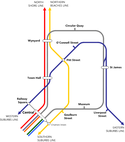|
City Circle
The City Circle is a mostly-underground railway line located in the Sydney central business district and Haymarket, in New South Wales, Australia, that forms the core of Sydney's passenger rail network. The lines are owned by the Transport Asset Holding Entity, a State government agency, and operated under Transport for NSW's Sydney Trains brand. Despite its name, the City Circle is of a horseshoe shape, with trains operating in a U-shaped pattern. The constituent stations of the Circle are (clockwise): Central, Town Hall, Wynyard, Circular Quay, St James, Museum and back to Central. History and descriptionThe original concept for the City Railway was part of a report dated 1915 submitted to the government by chief railway engineer, John Bradfield, upon his return from overseas study,[1] with work commencing the following year. His concepts were largely based on the New York City Subway, which he observed during his time in New York City.[2][3]  Built in stages, the first City Circle stations to open were the heritage-listed[4] Museum and St James, which both opened in 1926 as part of the initial electrification of Sydney railways. Next was the "western limb" through Town Hall and Wynyard, which opened in 1932 in conjunction with the opening of the Sydney Harbour Bridge. This section contains four tunnels. Two connected to the Harbour Bridge, while the two City Circle tunnels terminated at Wynyard. In 1956, the dead ends at St. James and Wynyard were joined and the "missing link", Circular Quay – was opened. Central and Circular Quay stations are above-ground (Circular Quay is elevated, directly underneath the Cahill Expressway), while the remainder are underground. Several unused railway tunnels also exist. The former tram tunnels at Wynyard, and other stub tunnels at St James are well known. The original railway network for the Sydney CBD planned by John Bradfield, (left) and the network as it is today. The City Circle was built as planned and the Eastern Suburbs railway was built to a different alignment, though the Northern Beaches and Southern Suburbs line was never built. The City Circle is double track throughout, although it forms four tracks at Central as there are two ends of the same track. The outer track is known as the "City Outer" and is used by trains travelling clockwise around the City Circle. In the direction of travel it passes through Central platform 17, Town Hall platform 6, Wynyard platform 6, Circular Quay platform 2, St James platform 2, Museum platform 2. Trains can then either proceed to Central platform 22 or 23, depending on which line they are running on. Similarly, the inner track is known as the "City Inner" and is used by trains travelling anti-clockwise. It starts from Central platform 20 or 21, again depending on which line a train is coming from. It then passes through Museum platform 1, St James platform 1, Circular Quay platform 1, Wynyard platform 5, Town Hall platform 1 then Central platform 19. Services and operations
The current service patterns generally consist of trains from the Inner West & Leppington Line running into the City Circle Outer, becoming Airport & South Line trains as they enter the circle. Conversely, trains from the Airport & South Line generally run into the City Circle Inner, becoming Inner West & Leppington Line trains. Liverpool & Inner West Line trains also operate via the City Circle Inner. A set of flying junctions at Central enable these patterns to be varied. Prior to the integration of the Eastern Suburbs line into the Illawarra Line in 1980, Illawarra line trains also operated around the City Circle. Trains on the Western and Northern lines usually do not use the City Circle but instead, proceed across the Harbour Bridge to the North Shore line and vice versa. Speed control and reduced overlapFor more information about signalling, see Australian railway signalling  StationsThe line has six stations.
See also
References
External links
|
||||||||||||||||||||||||||||||||||||||||||||||||||||||||||||||||||||||||||||||||||||||||||||||||||||||||||||||||||||||||||||||||||||||||||||||||||||||||||||||||||||||||||||||||||||||||||||||||||||||||||||||||||||||||||||||||||||









